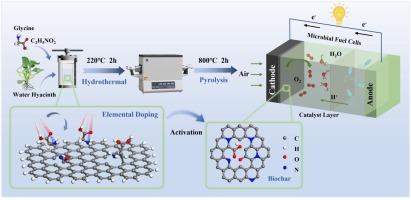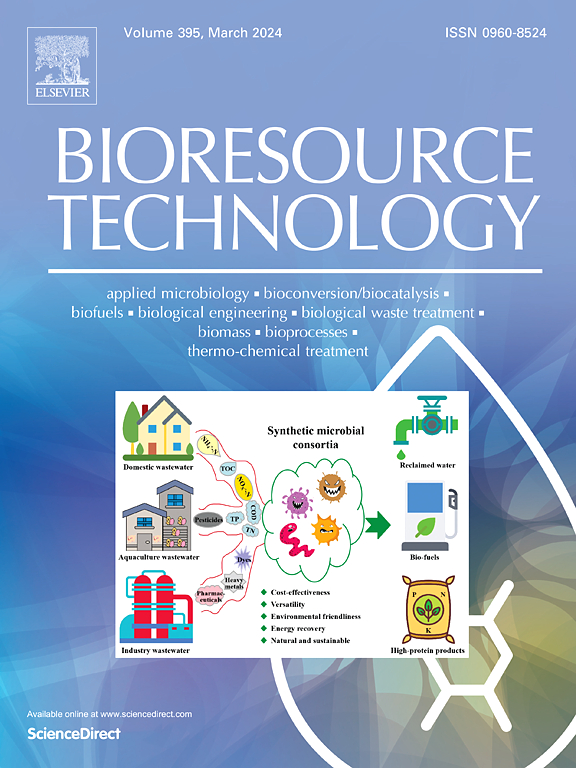水热法原位掺氮制备生物炭,用于增强微生物燃料电池中的氧还原反应。
IF 9.7
1区 环境科学与生态学
Q1 AGRICULTURAL ENGINEERING
引用次数: 0
摘要
掺氮碳材料被认为是微生物燃料电池(MFCs)前景广阔的阴极催化剂。其挑战在于降低成本和提高电催化活性含氮官能团的比例。本研究提出了一种水热介导的原位掺杂法,利用水生植物生产掺氮生物炭。在水热处理过程中,氮原子被锚定在碳结构中。随后的热解将水碳转化为具有高催化活性芳环结构的催化剂(HC-N+PY)。制备的 HC-N+PY 电催化剂具有出色的氧还原反应活性,半波电位为 0.82 V。理论计算表明,缺陷部位的石墨氮和 C-O 基团的协同效应增强了对 O2 的吸附和质子化作用。这项工作凸显了利用从水生植物中提取的掺氮生物炭作为有效催化剂来提高微生物燃料电池性能的潜力。本文章由计算机程序翻译,如有差异,请以英文原文为准。

Hydrothermal-mediated in-situ nitrogen doping to prepare biochar for enhancing oxygen reduction reactions in microbial fuel cells
Nitrogen-doped carbon materials are deemed promising cathode catalysts for microbial fuel cells (MFCs). The challenge lies in reducing costs and enhancing the proportion of electrocatalytically active nitrogenous functional groups. This study proposes a hydrothermal-mediated in-situ doping method to produce nitrogen-doped biochar from aquatic plants. The nitrogen atoms are anchored in the carbon structure during hydrothermal treatment. Subsequent pyrolysis converts the hydrochar into a catalyst with highly catalytically active aromatic ring structure (HC-N+PY). The as-prepared HC-N+PY electrocatalyst demonstrates superior oxygen reduction reaction activity with half-wave potentials of 0.82 V. The MFC with HC-N+PY exhibits excellent performance, with a peak power density of 1444 mW/m2. Theoretical calculations demonstrate that the synergistic effect of graphitic nitrogen and C–O groups at defect sites enhances O2 adsorption and protonation. This work highlights the potential of utilizing nitrogen-doped biochar derived from aquatic plants as an effective catalyst for enhancing the performance of microbial fuel cells.
求助全文
通过发布文献求助,成功后即可免费获取论文全文。
去求助
来源期刊

Bioresource Technology
工程技术-能源与燃料
CiteScore
20.80
自引率
19.30%
发文量
2013
审稿时长
12 days
期刊介绍:
Bioresource Technology publishes original articles, review articles, case studies, and short communications covering the fundamentals, applications, and management of bioresource technology. The journal seeks to advance and disseminate knowledge across various areas related to biomass, biological waste treatment, bioenergy, biotransformations, bioresource systems analysis, and associated conversion or production technologies.
Topics include:
• Biofuels: liquid and gaseous biofuels production, modeling and economics
• Bioprocesses and bioproducts: biocatalysis and fermentations
• Biomass and feedstocks utilization: bioconversion of agro-industrial residues
• Environmental protection: biological waste treatment
• Thermochemical conversion of biomass: combustion, pyrolysis, gasification, catalysis.
 求助内容:
求助内容: 应助结果提醒方式:
应助结果提醒方式:


